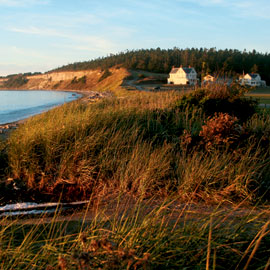| War and Peace
Once bustling
with soldiers,
Camp Casey
now celebrates
50 years as SPU’s
island getaway
for research,
recreation,
and renewal
CREATION DECLARES GOD'S GLORY, SAYS THE Psalmist, and the beauty at Camp Casey on Whidbey Island is a
hallelujah chorus. For half a century, generations of Seattle Pacific
University students, alumni, and visitors have found refuge in the
property’s natural wonders.

When Seattle Pacific President C. Hoyt Watson decided the College should buy the 80-acre Camp Casey property, some skeptics called the purchase "Watson's Folly." Through subsequent gifts and purchases, SPU now owns 300 acres at Casey.
|
 |
It’s ironic, really, when one considers Fort Casey’s history as
an essential part of Puget Sound’s defense against battleships.
The U.S. military broke ground on Fort Casey in 1897 along
the west coast of Whidbey. Named for Brigadier General Thomas
Lincoln Casey, the fort joined Fort Flagler and Fort Worden in
discouraging attempts to penetrate Puget Sound. It worked; no
attacks were mounted, and no battles were fought there.
In 1954, the Army declared the property surplus. Recognizing
the site’s potential to become a center for educational and recreational
activity, Seattle Pacific College purchased the north half of the territory in 1956. This area, called Camp Casey, included
officers’ houses, soldiers’ barracks, dining facilities, an auditorium,
and a gymnasium. The remainder of the property, with the
actual fort, was acquired by Washington State Parks.
When SPC President C. Hoyt Watson sent a team to assess
the new purchase, Ken Foreman, then chair of the Physical
Education Department, found the facilities “filled with rubble.”
He and Charles Shockey, Camp Casey’s first director, prepared
softball fields, nature trails, and tent-ready campsites. Student
volunteers made the trek north to clean up the buildings, and
for the next five decades the camp became a beloved setting for a
host of academic programs, athletic events, and retreats.
Cross country coach Doris Heritage recalls that her first visit
to Casey, as a Seattle Pacific freshman in 1960, was by boat.
Later, as a coach, she inherited the Falcon Running Camp at Casey from Foreman, and it has been going strong for more than
40 years. “Ebey’s Landing Trail from Casey is absolutely the best
place to run in the whole world,” says Heritage. Her colleague,
soccer coach Cliff McCrath, hosted the first Northwest Soccer
Camp at Camp Casey in 1972, and this eight-week program for
boys and girls has enjoyed popular success ever since.
During the 1970s, students enrolled in Casey Quarter, studying
ecology, geology, and literature while sharing meals and living
quarters. Of the countless other student activities at Casey, some
have been entirely self-initiated. During the summer of 1991, for
instance, Casey student employees read original works and classic
literature aloud by candlelight in the Thomas Parker bunker
— and “The Thomas Parker Society” continues in Seattle today.
Casey has always meant something special to alumni and their
families. For 38 years, they made memories at Casey Alumni
Weekend. The annual getaway included worship services, “Alumni
College” classes, beachcombing, and a traditional salmon barbecue.
Today, in addition to students and alumni, Seattle Pacific’s
Camp Casey Conference Center is enjoyed year-round by nonprofit
organizations, churches, sports teams, service organizations,
and other groups. Adding up annual “camper days” — overnight
stays by individual campers — Guest Group Program Coordinator
Mitch Richards ’87 counts 38,000. Each year, approximately
4,000 children from Northwest elementary schools come to Casey
to learn about marine life, and natural and cultural history.
Casey’s natural assets make it a place unlike any other, says
SPU Professor of Educational Ministry Bob Drovdahl. He recalls
watching a dazzling sunset from Company Quarters J while at
Faculty Retreat: “In my view, Casey matches in natural beauty any
place on earth, and I applaud God’s artistry every time I’m there.”
— By Jeffrey Overstreet
— PHOTOS BY Mitch Richards and Mike Siegel
Back to the top
Back to Home |
